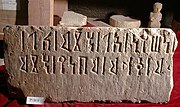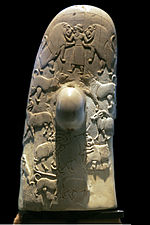The Proto-Sinaitic script is a Middle Bronze Age writing system known from a small corpus of about 30-40 inscriptions and fragments from Serabit el-Khadim...
57 KB (5,026 words) - 14:09, 2 January 2025
Proto-Canaanite is the name given to the (a) the Proto-Sinaitic script when found in Canaan, dating to about the 17th century BC and later. (b) a hypothetical...
13 KB (1,275 words) - 10:24, 13 December 2024
Sinaitic script could refer to: Nabataean script, the script previously known as Sinaitic as most examples were found in the Sinai Proto-Sinaitic script...
214 bytes (59 words) - 21:46, 5 April 2023
Phoenician alphabet (redirect from Phoenician script)
horizontally, from right to left. It developed directly from the Proto-Sinaitic script used during the Late Bronze Age, which was derived in turn from...
53 KB (4,066 words) - 05:57, 19 December 2024
The Serabit el-Khadim proto-Sinaitic inscriptions are about 30 early alphabetic inscriptions in proto-Sinaitic script found at or in the vicinity of Serabit...
15 KB (688 words) - 01:09, 17 August 2024
scholars, who also believe that these scripts are descendants of the Proto-Sinaitic script. Paleo-Hebrew script was used by the ancient Israelites, both...
10 KB (488 words) - 03:10, 28 December 2024
Paleo-Hebrew alphabet (redirect from Proto-Hebrew)
immediate predecessor script Proto-Canaanite (Late Proto-Sinaitic) during the 13th to 12th centuries BCE, and earlier Proto-Sinaitic scripts. The earliest known...
38 KB (3,810 words) - 10:52, 17 December 2024
alphabetic scripts used throughout the world today ultimately go back to this Semitic script. Its origins can be traced to the Proto-Sinaitic script that represented...
48 KB (3,558 words) - 07:07, 18 December 2024
Alphabet (redirect from Alphabetic script)
used to transcribe foreign words. The first fully phonemic script was the Proto-Sinaitic script, also descending from Egyptian hieroglyphs, which was later...
61 KB (6,931 words) - 07:23, 13 December 2024
Ancient South Arabian script (Old South Arabian: 𐩣𐩯𐩬𐩵 ms3nd; modern Arabic: الْمُسْنَد musnad) branched from the Proto-Sinaitic script in about the late...
27 KB (1,310 words) - 04:44, 7 January 2025
The South Semitic scripts are a family of alphabets that had split from Proto-Sinaitic script by the 10th century BC. The family has two main branches:...
2 KB (158 words) - 03:05, 6 October 2024
Writing system (redirect from Script system)
Most of the world's alphabets either descend directly from this Proto-Sinaitic script, or were directly inspired by its design. Descendants include the...
42 KB (5,128 words) - 21:35, 2 January 2025
correct identification of the character of the Proto-Sinaitic script, the ancestor of almost all alphabetic scripts. Petrie developed the system of dating layers...
42 KB (4,686 words) - 20:25, 1 January 2025
There are various styles of the Modi script associated with a particular era. Many changes occurred in each era The proto-Modi, or ādyakālīn (आद्यकालीन्) style...
19 KB (1,753 words) - 03:29, 28 November 2024
considered Nabataean were found in Sinai, and another 4,000 – 7,000 such Sinaitic inscriptions remain unpublished. Prior to the publication of Nabataean...
15 KB (789 words) - 19:27, 28 September 2024
craftsman god Kothar-wa-Khasis, not El. In an inscription in the Proto-Sinaitic script, William F. Albright transcribed the phrase ʾL Ḏ ʿLM, which he translated...
54 KB (6,564 words) - 14:18, 22 December 2024
was connected to the Proto-Sinaitic script, and which was transmitted across the Mediterranean and used to develop the Arabic script and Greek alphabet...
110 KB (12,453 words) - 15:07, 27 December 2024
The Latin script, also known as the Roman script, is a writing system based on the letters of the classical Latin alphabet, derived from a form of the...
39 KB (3,950 words) - 03:50, 6 January 2025
India that appeared as a fully developed script in the 3rd century BCE. Its descendants, the Brahmic scripts, continue to be used today across South and...
165 KB (15,014 words) - 02:41, 4 January 2025
Ugaritic alphabet (redirect from Ugar (script))
some have suggested that Ugaritic represents some form of the Proto-Sinaitic script, the letter forms distorted as an adaptation to writing on clay...
17 KB (1,436 words) - 18:49, 18 December 2024
the ancestor of aleph may have been a pictogram of an ox head in proto-Sinaitic script influenced by Egyptian hieroglyphs, styled as a triangular head...
33 KB (2,740 words) - 17:28, 1 January 2025
Mongolian script. Without proper rendering support, you may see question marks, boxes, or other symbols instead of text in Mongolian script. The traditional...
120 KB (5,097 words) - 16:06, 5 January 2025
voiced alveolar plosive ([d]). The letter is based on a glyph of the Proto-Sinaitic script, probably called dalt "door" (door in Modern Hebrew is delet), ultimately...
8 KB (662 words) - 21:54, 16 December 2024
lyre added the rest. Below is a table synoptically showing selected Proto-Sinaitic signs and the proposed correspondences with Phoenician letters. Also...
39 KB (3,250 words) - 14:55, 16 December 2024
that the Phoenician script evolved from the Harappan script, and not, as the classical theory suggests from the Proto-Sinaitic script. He compared it to...
64 KB (6,303 words) - 21:56, 6 January 2025
Tifinagh (redirect from Tifinagh script)
ⵜⵉⴼⵉⵏⴰⵖ; Berber Latin alphabet: Tifinaɣ; Berber pronunciation: [tifinaɣ]) is a script used to write the Berber languages. Tifinagh is descended from the ancient...
36 KB (3,119 words) - 19:11, 6 January 2025
Retrieved June 24, 2024. LeBlanc, Paul (2017). Deciphering the Proto-Sinaitic Script: Making Sense of the Wadi El-Hol and Serabit El-Khadim Early Alphabetic...
14 KB (1,201 words) - 18:33, 31 December 2024
display the uncommon Unicode characters in this article correctly. The Cham script (Cham: ꨀꨇꩉ ꨌꩌ)is a Brahmic abugida used to write Cham, an Austronesian language...
21 KB (1,456 words) - 18:48, 24 December 2024
cognate with those of Phoenician, and may thus be assumed for the Proto-Sinaitic script. Two writing systems were used to write the Geʽez language: an abjad...
49 KB (2,888 words) - 10:28, 27 December 2024
"In the northeast, the local derivative of Siddhamatrka was the script known as Proto-Bengali or Gaudi, which was current from the tenth to the fourteenth...
35 KB (2,449 words) - 02:05, 6 January 2025























